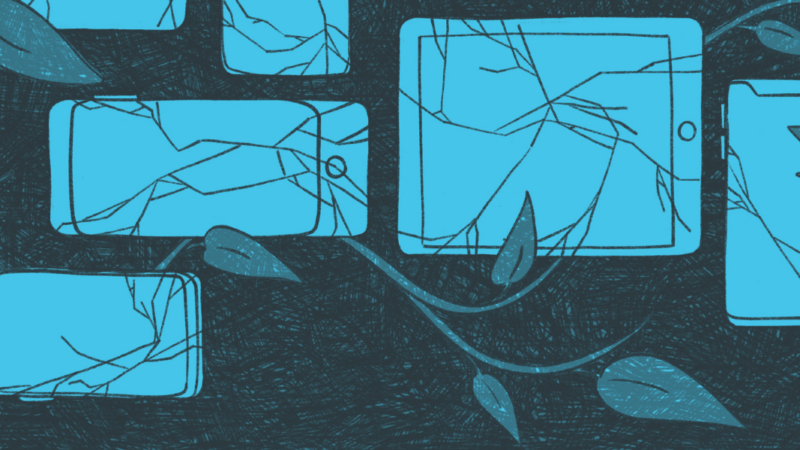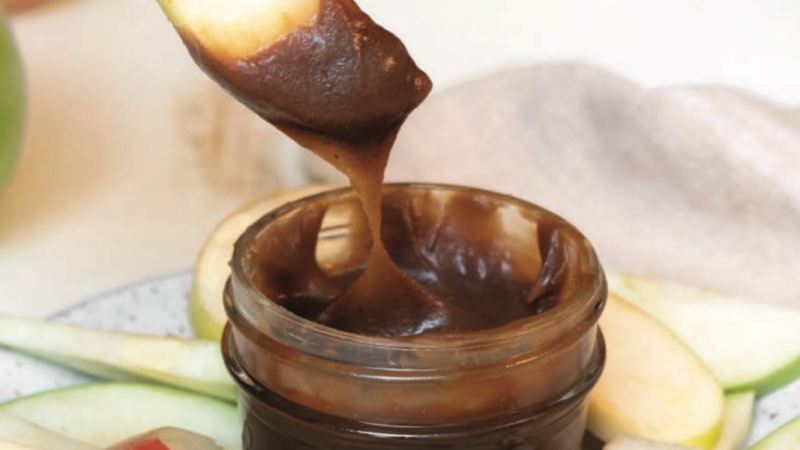The Power in Writing Your Obituary

While many of us spend December celebrating the holidays, this is also the perfect time for reflection—and for death and rebirth. Writing as a path to awakening is an invitation and celebration—it’s your ticket back to your creative brilliance.
Life is short. Time is fleeting and invented—it’s only really ever now. Love is showing up fully with presence—open-hearted, raw, and vulnerable to the world; it’s the only thing that matters. And it’s with this that I invite you to write your own obituary.
Reflecting on our own mortality is an opportunity to assess what is truly important in our lives. To reflect on our own mortality is to enter into the community of humanity via the ultimate vulnerability around ceasing to exist. When we approach this with an open heart of curiosity, we have a chance at greater compassion, patience, and understanding with the realization that we are all in this together.
Every one of us goes through this fact of our temporary nature in physical form; there is no getting out of this world alive. And here we have a choice—we can put off that reality, ignore it, get completely freaked out about it, or we can face that fact with courage and curiosity.
It’s so easy to get caught up in the mundane details and challenges of daily life to the extent that we can forget what we are really living for—what our core purpose in this lifetime truly is! The results of such an investigation are a more awakened sense of self, a deepening compassion for yourself and others—not only those intimate in your life—but for humanity as a whole.
Begin by writing it as a list or try writing it as a poem. Tune into any fears or resistances that arise. You could try modeling your piece on a traditional obituary you might read in your favorite newspaper or online magazine. Freewrite into these questions and see what arises.
- How do you want to be remembered?
- What are the true highlights of your life?
- Who were the people who most inspired or influenced you?
- What did you learn being embodied in this life that you want to share with others?
- What held the most meaning for you in your days on this earth?
Looking for more great reads?
Adapted excerpt from Writing As a Path to Awakening by Albert Flynn DeSilver.
 A highly regarded and sought-after speaker and workshop leader, Albert Flynn DeSilver has taught and presented with several luminaries, including Elizabeth Gilbert, Cheryl Strayed, Maxine Hong Kingston, Michael McClure, and U.S. Poet Laureate Kay Ryan among many others. In addition, Albert is an internationally published poet, memoirist, and novelist. His writing has appeared in over 100 literary journals worldwide. He has published several books of poetry and the memoir, Beamish Boy. Albert teaches at the Omega Institute, Esalen, Spirit Rock, and writing conferences nationally. He lives in Northern California.
A highly regarded and sought-after speaker and workshop leader, Albert Flynn DeSilver has taught and presented with several luminaries, including Elizabeth Gilbert, Cheryl Strayed, Maxine Hong Kingston, Michael McClure, and U.S. Poet Laureate Kay Ryan among many others. In addition, Albert is an internationally published poet, memoirist, and novelist. His writing has appeared in over 100 literary journals worldwide. He has published several books of poetry and the memoir, Beamish Boy. Albert teaches at the Omega Institute, Esalen, Spirit Rock, and writing conferences nationally. He lives in Northern California.
Learning the Art of Thriving Online
Amelia Knott is an art psychotherapist who specializes in the mental health impacts of hustle culture and social media. In the video below (3:22 minutes), she shares her inspiration behind her written and illustrated workbook, The Art of Thriving Online: Creative Exercises to Help You Stay Grounded and Feel Joy in the World of Social Media and invites you in on the journey of reimagining a healthier relationship with the digital world.
https://soundstrue-ha.s3.amazonaws.com/video/Learning-the-Art-of-Thriving-Online.mp4
You can also read the video transcript below:
It’s been half my life—literally half the years of my life—lifting my chin for pictures, anticipating the critical gaze of a digital audience, offering my presence half-heartedly to the world around me to to draft a clever caption, choose a flattering filter, and watch as my phone tells me if this time my work will be rewarded with worthiness.
Too many nights avoiding myself, letting the blue-light-lullaby of my screen become a substitute for true soothing. It’s been half my life; holding up the mirror of comparison to everyone’s best days and hottest takes, highlight reels curated with effortless nonchalance, and now the mirror of comparison to a perfected self made in the algorithm’s image. It’s been half my life of fractured attention, commodified vulnerability, fury, and fear taking turns with despondence.
What if my real life stopped being my body or the land, and became the non-place I devote my hours to?
And it’s been half my life wandering daily into the galleries of artists’ and thinkers’ most beautiful ideas. Half my life keeping far-away loved ones close.
It’s true that the Internet gave me my career, my marriage. It made visible the threads of similarity across a quickly dividing globe. It showed me life-saving examples of people who survived what I needed to survive and it broke my heart open at the things no one should have to.
I like to misquote Carl Jung when he said something almost like “a paradox is our most valuable spiritual tool.” I’m not interested in finding the elusive, singular hack that will make screen time less alluring forever. I’m not interested in a lifetime of cycling through eras of detox and excess. Vacillating between the high of a new regimen and the crash of shame when social media works once again, exactly as it was designed.
I’m a therapist. I know that hacks can be tools, or bandaids. A self-help, step-by-step, sales pitch plan can feel like salvation, but it’s not the medicine of being in an evolving conversation with yourself. I am more interested in making art. I’m more interested in learning to tolerate the tension between social media’s danger and its magic. I’m more interested in learning to like myself, unsolved.
And when I’m learning the same lesson, again, the hard way, I know that my allies in finding safe passage through the digital age are art and writing. Creativity is how we imagine a different future.
So I wrote us this book. It’s a place to start that conversation with yourself about what is really happening between you and your screen; who profits from the ways it harms you, and how to protect the parts of it that are genuinely good, because parts of it are.
So if you are ready to join me—an art psychotherapist who both loves the life her phone enables and desperately needs to put it down—we’ll make some art. We’ll sit in the stunning and maddening paradox, and we’ll find creative ways to author our own definitions of real wellbeing when we choose to be on social media.
And together we’ll find the art of thriving online.
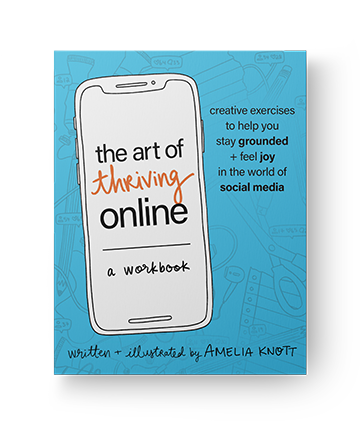
The Art of Thriving Online: A Workbook
Amazon | Barnes & Noble | Bookshop | Sounds True
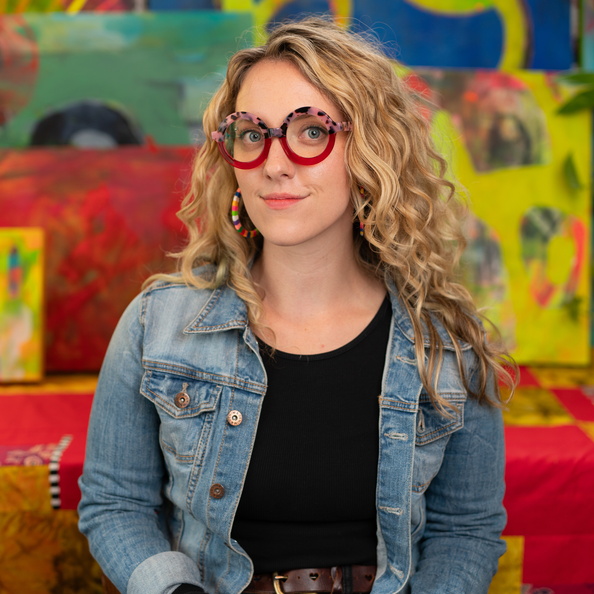
Amelia Knott
In 2020, Find Your Life’s Purpose (the japanese way)

Why do you get up every morning? What motivates you to get out of bed every day? In Japan there is a term to describe our reason for living or being: ikigai.
We all have an ikigai, even if we don’t know it.
In fact, the search for an ikigai is what will bring large doses of satisfaction and self-fulfillment because when you connect with your ikigai, your life will acquire a meaning. Often we live a life that is full of appearances, possessions that appear to speak for who we are, jobs that provide much prestige but that we don’t enjoy, inherited stereotypes, scraps of other lives, and only superficial meaning. But that life full of appearances has a tendency to crumble and fall apart, and, when it does, it’s usually in the form of a crisis. For some people, the crisis that tends to happen in adult life is an opportunity to ask ourselves what our ikigai is and what the meaning of our life is. However, when you are suffering, it’s not the best time to find a meaning for your life, because from a place of lacking, everything is harder.
Look for Your Ikigai
We have already established that at the very least you already have one ikigai, a reason to pick up your pieces. But I encourage you to think about what other ikigais you can find. Analyze the meaning of your life up until now and evaluate whether you need to redefine it.
Sometimes, because we have good intentions, we mistakenly believe that our lives consist only of our children, partners, work, parents, or a long list of other things, but in reality, you must never allow all your life’s responsibilities to revolve around a single meaning or a single motivation.
I have many ikigais that I carry with me every day! I get up for myself and for everything I enjoy doing. I get up for my wife and for my daughter, for my clients; to go for a stroll, to go for a bike ride, or to get lost skiing in the mountains; to use my talent to remove psychology from the confines of the lecture theater, to learn and teach, travel, smile, and enjoy a kiss and a hug. Each morning I get up for the bear hug I will give my daughter, to feel the sun on my skin, to get drenched in the rain, and to curl up with a good book. I could fill pages and pages with my ikigais, though that wouldn’t make as interesting a book, now would it?
An Exercise in Ikigai
To begin this exercise, ask yourself about the meaning behind what you are doing, where you are living, your work, your partner, your lifestyle, and your vacations. I encourage you to go over each and every one of the aspects of your life and to ask yourself whether they contribute to your happiness.
Start questioning the meaning of what you are about to do in each moment of your day. Even the mundane things! It may sound silly, but there is ikigai there!
What meaning is there in… Drinking a cup of coffee? Attending a specific conference? Helping a neighbor? In getting angry? In walking your dog? In writing a book?
Moving forward, continue to ask yourself about the meaning of what you are about to do in any moment, and there you will start to discover your own ikigais.
Learn more about the powerful practice of healing trauma and finding purpose in Kintsugi: The Japanese Art of Embracing the Imperfect and Loving Your Flaws by Tomás Navarro.

Tomás Navarro is a psychologist who loves people and what they feel, think, and do. He is the founder of a consultancy practice and center for emotional well-being. He currently splits his time between technical writing, training, consultancy, conferences and advisory processes, and personal and professional coaching. He lives in Gerona and Barcelona, Spain.
Read Kintsugi today!
Sounds True | Amazon | Barnes&Noble | IndieBound


A Living Practice: Take a Tour of the Nervous System Through Yoga

A practitioner in Tree Pose (or you can, of course, use any pose in this exploration) can experience the different layers of neural processing stacked atop each other, even if unconsciously. The structure and experience of Tree Pose itself reflect the hierarchical structure of the nervous system; the stability of the lower, sensory layers is like the trunk of a tree, whereas the higher, abstract layers are like the tree’s branches.
Whole Body
While you are positioned in Tree Pose, what information is available to you?
- At the bottom layer are the exteroceptive senses that perceive the external world (touch, smell, sight, taste, and hearing)
- Next are the proprioceptive senses—those that perceive the positions of neighboring body parts relative to each other
- Also at play is the equilibrio-ceptive sense, which measures the position of the body relative to gravity
Neck
Can you sense your heartbeat and breath while in Tree Pose?
- You cultivate the stability discovered through equilibrioception through autonomic functions controlled by the medulla and pons in the brain stem
Heart
What is your emotional experience while in Tree Pose?
Do any fears or past traumas influence your current experience, even unconsciously?
- The limbic system—comprised of numerous brain regions above the brain stem—is associated with assigning emotional value to experience
Head
When we inhabit an asana like Tree Pose with ease and stability, we experience multisensory integration in a refined and cohesive way.
- Mindfully paying attention to the body as we practice harnesses neuroplasticity, refining the neural pathways associated with processing signals from the body
What does it feel like to be you while in Tree Pose?
Feet
- The self-sense is the most abstract layer of the nervous system hierarchy; it’s associated with the brain’s DMN (default mode network). It is the part of the nervous system that generates a sense of selfhood, and it is also the capacity that allows the feeling of being me to occur.
Excerpted from Yoga & Psyche: Integrating the Paths of Yoga and Psychology for Healing, Transformation, and Joy by Mariana Caplan.

Mariana Caplan, PhD, MFT, E-RTY 500, is a psychotherapist, yoga teacher, and author of eight books in the fields of psychology, spirituality, and yoga. She has been teaching workshops and trainings online, in yoga studios and universities, and at major retreat centers throughout the world since 1997. She is the founder of Yoga & Psyche International, an organization created to integrate the fields of yoga and psychology globally, and lives in Fairfax, California. Learn more at realspirituality.com and yogaandpsyche.com.

Buy your copy of Yoga & Psyche at your favorite bookseller!
3 Ways to Deepen Gratitude This Holiday Season
It is true that misery cannot simultaneously exist alongside gratitude and that, despite ourselves, we are constantly being given more than we give. To prove that point, try this simple, elegant practice and see for yourself. Please note: If you resist doing this exercise, consider that you are doing so because you, like most human beings, prefer to believe that you give more than you receive. If you find you’re wrong, what will happen to your resentment or other feelings of disappointment?
Naikan Inventory List
Take a few full size notebook paper and draw three columns. At the top of column #1, write “What he/she/they gave to me.” At the top of column #2, write “What I gave to him/her/them.” At the top of column #3, write “The trouble I caused him/her/them. Exhaust each column with your list of SPECIFIC items before moving onto the next. The timeline to consider is the last 3 months. The use of “always” or “usually” should be avoided. Be precise.
Write three letters of gratitude
You should have enough evidence to write three separate letters of appreciation to your partner. Be sure to make each different, using alternate words expressing thanks to your partner. You can give your partner this letter (or card), or you can simply keep it to yourself. Your choice. The exercise was for you anyway.
Write three letters of apology
You should have enough evidence from your list to apologize for putting your partner out. Make each letter unique by saying “I’m sorry” in different ways. Again, you can give this to your partner or simply keep it private. Either way, the exercise does its magic. If you were honest and thorough, you might have noticed that column #2 was shorter than columns 1 & 3. We are selfish creatures; always aware of what we’re not getting and how our partners cause us grief.
I hope this exercise has helped deepen your gratitude during this holiday season!
 Stan Tatkin, PsyD, MFT, is a clinician and author who integrates neuroscience, attachment theory, and current therapies. He directs training programs throughout North America and globally. He is the author of We Do: Saying Yes to a Relationship of Depth, True Connection, and Enduring Love, Wired for Love: How Understanding Your Partner’s Brain and Attachment Style Can Help You Defuse Conflict and Build a Secure Relationship.
Stan Tatkin, PsyD, MFT, is a clinician and author who integrates neuroscience, attachment theory, and current therapies. He directs training programs throughout North America and globally. He is the author of We Do: Saying Yes to a Relationship of Depth, True Connection, and Enduring Love, Wired for Love: How Understanding Your Partner’s Brain and Attachment Style Can Help You Defuse Conflict and Build a Secure Relationship.
The community here at Sounds True wishes you a lovely holiday season! We are happy to collaborate with some of our Sounds True authors to offer you wisdom and practices as we move into this time together; please enjoy this blog series for your holiday season.
To help encourage you and your loved ones to explore new possibilities this holiday season, we’re offering 40% off nearly all of our programs, books, and courses sitewide. May you find the wisdom to light your way.
Vegan Salted Caramel
Vegan Salted Caramel
From the book, Whole Girl by Sadie Radinsky
Yield: Serves 10
INGREDIENTS:
- ½ cup coconut sugar
- ¾ cup full-fat coconut milk 2 tsp vanilla extract
- 1 tsp coconut oil
- ¼ tsp sea salt
- 2 – 5 apples, sliced, for dipping
INSTRUCTIONS:
- Whisk together the coconut sugar and coconut milk in a medium saucepan and bring to a boil over medium-high heat.
- Once the mixture has started boiling, turn down the heat to medium-low and let the caramel simmer for 20 to 25 minutes, whisking every couple minutes. If it starts to smell very strong, remove from heat; it could be burning. When the caramel appears to have thickened considerably and darkened in color, remove from heat.
- Slowly whisk in the vanilla extract, coconut oil, and sea salt. Let the caramel cool for at least 10 minutes, to thicken up more. Pour the caramel into a small jar. I recommend serving it with sliced apples for a healthy snack. Store any leftover caramel in a sealed jar in the refrigerator for up to 2 weeks.
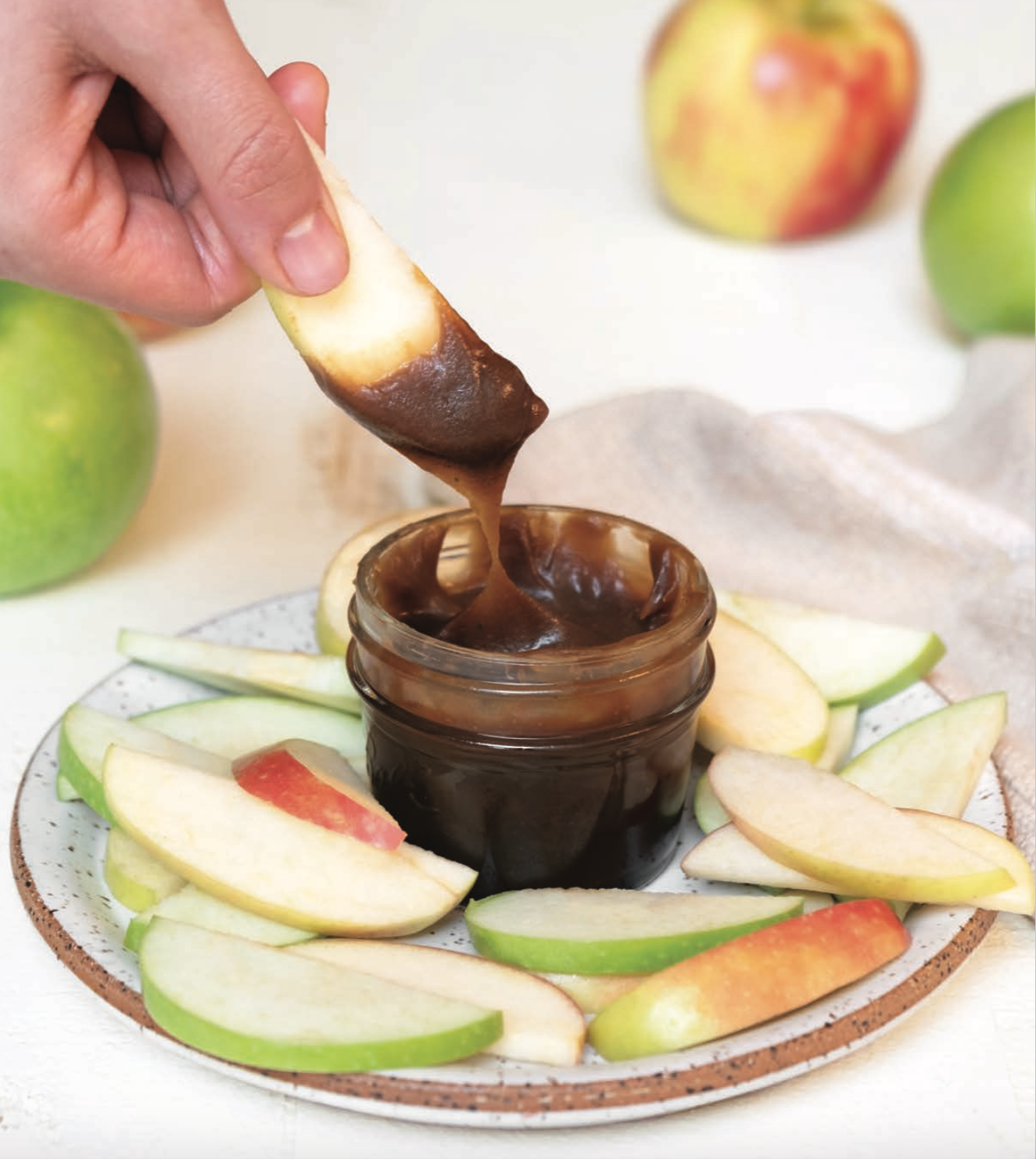

Sadie Radinsky is a 19-year-old blogger and recipe creator. For over six years, she has touched the lives of girls and women worldwide with her award-winning website, wholegirl.com, where she shares paleo treat recipes and advice for living an empowered life. She has published articles and recipes in national magazines and other platforms, including Paleo, Shape, Justine, mindbodygreen, and The Primal Kitchen Cookbook. She lives in the mountains of Los Angeles. For more, visit wholegirl.com.




